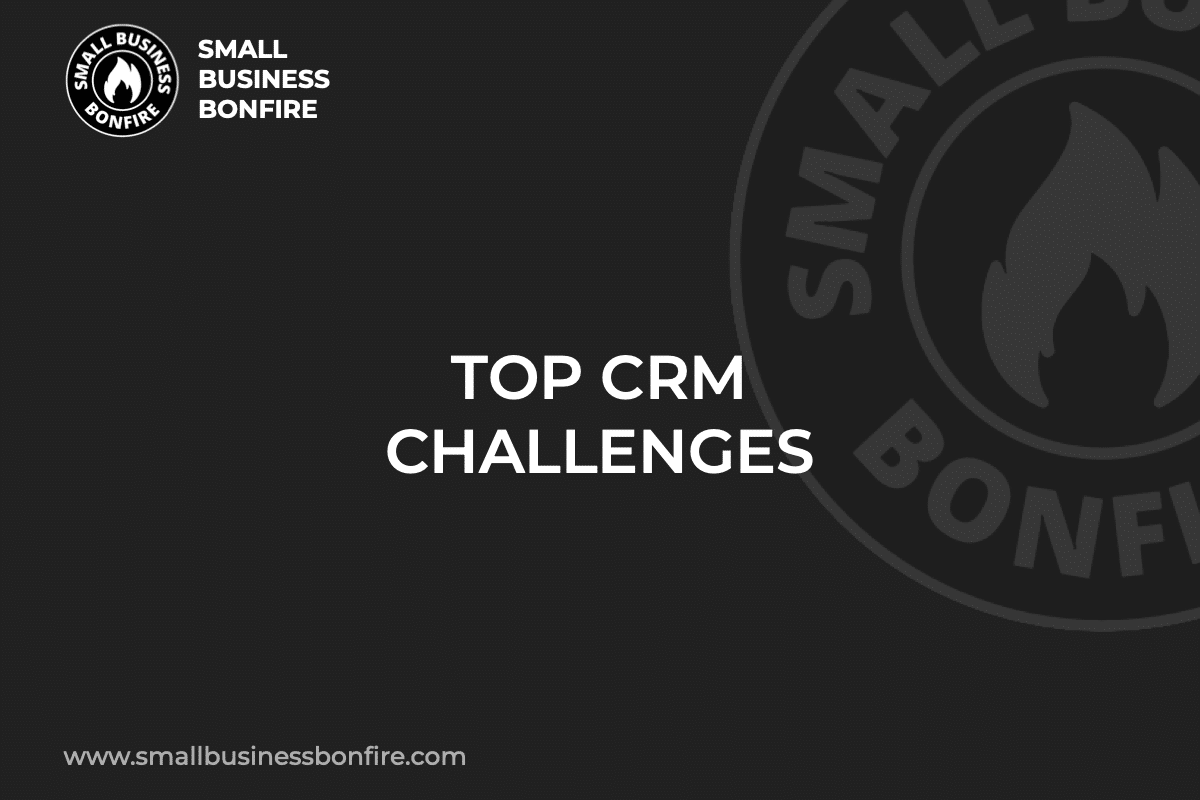Have you recently implemented a customer relationship management (CRM) platform but now face challenges like lack of team buy-in, low-quality data, and more?
Several new CRM users struggle to implement this technology successfully. So, if this sounds like you, there’s no need to worry!
Hi, my name is AJ! I recently sold my company for multiple seven figures to help other entrepreneurs find success in their industry.
One detail that took my company from struggling to booming was overcoming challenges associated with CRM software!
So, if you want to finally use your CRM the right way, keep reading! I’m revealing everything (and more) you need to know!
Key Takeaways
- Lack of team buy-in is the number one reason CRM implementations fail.
- Businesses can avoid overspending on CRM technology by utilizing free trials and programs.
- When teams don't have CRM goals, it leads to a significantly higher chance of implementation failure.
Related Reading: Small Business CRM
SBB Featured Partners
CRM Problem: Cost of CRM Software
One of the most common reasons people don’t adopt a CRM system is the cost associated with the software.
This hesitation is understandable, as some CRM systems cost thousands of dollars each month.
Also, as a small business owner, considering each expense is crucial!
I remember carefully counting each dollar my company spent during the beginning stages of our operations.
Therefore, when CRM systems come with a high price tag, small business owners can hesitate to implement them because they’re unsure if it will pay off.
On top of that, some CRM providers charge per user.
So, companies with multiple employees must pay more to implement and use the system if they want it to be effective.
As you can see, there are several reasons the cost of CRM software can be the primary reason small businesses don’t utilize the advanced technology.
Solution:
Is there a solution to the high price of some CRM systems?
Fortunately, the answer is yes!
For example, one way to avoid overspending on a CRM system is to utilize the free trials (most) providers offer.
When you take advantage of free trials, your business can enjoy the following things:
- A lower chance of adopting a CRM that doesn’t match your company’s needs
- A higher chance of user buy-in
- A lower chance of wasting time, energy, resources, and money on a CRM program
- A higher chance of CRM success
Another way to avoid spending too much on a CRM solution is to find a provider designed for beginners.
For instance, popular CRM providers like HubSpot offer advanced tools and solutions for $0 monthly!
That way, you and your team can save money while enjoying all the awesome things CRM software can do!
CRM Problem: Implementation Time of a CRM Solution
The implementation time of a CRM solution refers to the time it takes to fully integrate the system into your business operations.
CRM implementation considers everything from installation to complete utilization!
CRM implementation can be a lengthy process because it requires the following things:
- Software installation
- Customer data migration
- Configuration to tailor the CRM to your specific business needs
- Training employees on how to use the system effectively
- Comprehensive measures to ensure robust data security, given the sensitive customer information stored within the system
Businesses often underestimate the time it takes for CRM implementation to be fully completed.
For instance, many small business owners assume that it can be up and running immediately once they buy the CRM system.
However, depending on the CRM’s complexity and the business’s size, the implementation can take a few weeks to several months.
CRM implementation is a crucial phase that requires meticulous planning and patience.
Rushing through CRM implementation can lead to missteps, resulting in inefficient system use or failure to leverage its full potential!
Solution:
Thorough planning is crucial to solving the problem of CRM implementation challenges!!
It’s best to start by creating a detailed CRM implementation timeline that factors in the following things:
- Customer data migration
- Data configuration
- Employee training
Finally, consider hiring a CRM consultant or implementation specialist who can guide your team through the process and avoid common pitfalls.
As a result, this ensures a successful and efficient CRM implementation, avoiding a CRM implementation fail!
CRM Problem: Data Quality
The issue of data quality poses another significant challenge for new AND experienced CRM users.
Poor data quality is a problem that emerges when the CRM system has outdated, incomplete, or inaccurate customer information.
As a result, this reduces the effectiveness of the CRM software and leads to misguided strategies or decisions.
For instance, duplicate customer records may result in wasted marketing efforts or a disjointed customer experience.
Similarly, inaccurate customer details could mislead your sales team or result in failed communication attempts, negatively impacting customer relationships!
Solution:
Addressing the issue of poor data quality begins with establishing a clear data management protocol!
A data management protocol should include the following things:
- Guidelines on data entry
- Regular cleaning of data to remove duplicates
- Constant updates for outdated information
- Validation checks to ensure data accuracy
On top of that, integrating your CRM system with other data sources will help keep information current and comprehensive.
As a result, excellent data management enhances your CRM efforts’ overall efficiency and effectiveness!
CRM Problem: Team Communication
Poor team communication is a significant challenge when companies implement a new CRM system.
Poor communication often stems from inadequate information sharing or a lack of collaboration tools within the CRM system!
Typically, a lack of efficient communication manifests in the following ways:
- Missed messages
- Unclear task assignments
- Disjointed customer interactions
Is poor communication that big of a deal? YES!
When your team doesn’t communicate correctly, it can lead to a poor customer experience.
For example, a sales representative might not be aware of a recent interaction between the customer and support team, resulting in redundant or irrelevant conversations.
Solution:
To tackle the issue of poor team communication, a CRM solution with integrated collaboration and communication tools is vital!
These tools can include the following features:
- Built-in chat features
- Task assignment capabilities
- The ability to log and track all customer interactions across departments
These tools ensure everyone on the team can access real-time, accurate customer information.
As a result, this fosters better collaboration, streamlined workflows, and a more unified customer experience!
CRM Problem: Team Buy-In
Lack of team buy-in is a significant CRM challenge because it can drastically affect the utilization and success of the system.
Poor team buy-in is a problem that happens because employees are resistant to a new system, resulting in the following things:
- Poor adoption rates
- Suboptimal usage
- Diminished return on investment
Without your team’s full enthusiasm and commitment, even the most advanced CRM software can fail to deliver its potential benefits!
Solution:
To overcome the challenge of poor team buy-in, involving your team in the customer relationship management selection process is essential.
Also, providing thorough training on how to use CRM tools and explaining the various benefits is beneficial.
Constant communication about the CRM’s role in improving each department’s workflow and recognition and rewards for its effective use can foster a sense of engagement.
Further, appointing CRM leaders from within the team can help drive adoption because they can assist peers with queries and concerns, making the transition smoother!
CRM Problem: No CRM System Goals
The lack of clear CRM system goals is a substantial hurdle because it can result in aimless and inefficient use of resources.
When businesses don’t have specific objectives for their CRM implementation and use, they may fail to leverage its robust capabilities fully.
This issue usually results in the following things:
- An inability to measure CRM success
- A lack of focus on strategy
- Failure to align CRM usage with overarching business goals
Unfocused CRM usage can lead to wasted resources and missed opportunities to enhance customer engagement and satisfaction!
Solution:
To effectively tackle the lack of clear CRM goals, it’s essential to establish SMART goals.
SMART ensures goals are:
- Specific
- Measurable
- Attainable
- Relevant
- Time-bound
Your goals must align with the broader business strategy and focus on enhancing customer experience, improving sales and marketing efforts, and fostering efficient team collaboration!
Also, regularly reviewing and adjusting these goals based on the business’s evolving needs will ensure optimal usage of your CRM system.
CRM Problem: Team Training
Team training can present small business owners with various challenges as they implement a new CRM.
Team training involves familiarizing the entire team with a new system, which can be complex and time-consuming.
Therefore, some employees may need help understanding and adapting to the new processes, interfaces, and functionalities.
As a result, some employees are resistant to change!
Further, poor or inadequate training can lead to costly mistakes, such as the following:
- Data entry errors
- Miscommunication
- System misuse
- Failure to use certain tools
Solution:
How do you ensure you train your team correctly when implementing CRM technology?
First, it’s helpful to have a CRM implementation plan.
These plans outline each step your team needs to take to avoid failure of CRM implementation!
Also, ensure you block out ample time for your team to learn how to use CRM technology, systems, and tools.
Remember, some employees may catch on right away, while others may demand more time to learn how to use new technology.
CRM Problem: CRM (Customer Relationship Management) Doesn't Meet Team Needs
A customer relationship management system that doesn’t meet the team’s needs can be problematic.
For instance, when the system doesn’t match your team’s demands, it can hinder productivity and create inefficiencies rather than streamlining tasks and boosting customer relationships!
How do you know a CRM doesn’t match your team’s needs?
Look for these indicators:
- Overley complex technology
- Lack of necessary features
- Features that aren’t designed for your industry
This can make it difficult for team members to carry out their roles effectively.
Consequently, when CRMs don’t perform like you need, it might lead to the following things:
- Lower adoption rates
- Increased frustration
- Decreased customer satisfaction due to slower response times or errors in customer communication
Solution:
Investing in flexible and customizable software is crucial to address the challenge of a CRM system that doesn’t meet your team’s needs.
That way, you can tailor the processes to your specific business requirements and industry.
Choosing the right software involves the following actions:
- Researching different CRM systems
- Understanding CRM features
- Evaluating how features align with your team’s workflows and processes
CRM Problem: Minimal Management Buy-In
Minimal management buy-in is another common CRM problem, leading to the following things:
- Insufficient resource allocation
- Less emphasis on proper training
- Lack of enforcement of CRM usage
Lack of management buy-in can also lead to inconsistent organizational CRM usage.
After all, how likely will employees be to adopt something new if their managers don’t even do it?
Solution:
It’s vital to emphasize the benefits of CRM at the managerial level to overcome the challenge of minimal management buy-in.
For instance, demonstrating how the system can streamline processes, increase efficiency, and improve customer relationships can help secure their support!
Also, management should be encouraged to lead by example, consistently using the CRM software to promote adoption throughout the team.
CRM Problem: Integration Issues
Integration issues can disrupt the seamless data exchange between various business applications and the CRM system.
These problems can surface as:
- Errors in data transfer
- Inability to synchronize real-time data
- Complete data silos where information isn’t shared between systems
As a result, the organization ends up with disjointed customer data.
And unorganized data can lead to inefficiencies, inaccurate reporting, and overall poor customer experience!
Solution:
You can solve this problem by selecting CRM software that supports integrations, which can seamlessly connect and synchronize with your business tools.
As a result, these integrations create a unified and efficient system that promotes accuracy and real-time data sharing!
CRM Problem: Limited Reporting & Analytics
Limited reporting and analytics in CRM systems restrict the ability to analyze customer data comprehensively and draw valuable insights.
Without in-depth analytics, businesses may miss out on crucial trends, patterns, and opportunities for improvement.
Ultimately, poor reporting hinders a company’s ability to make data-driven decisions that enhance client relationships and boost sales.
Solution:
Investing in a CRM solution with robust analytics capabilities is crucial to tackling the problem of limited reporting and analytics.
Powerful reporting capabilities will power your business with data-driven insights.
As a result, these reporting tools can help you do the following things:
- Track customer behavior
- Detect patterns
- Make strategic decisions to enhance customer engagement and sales
CRM Problem: Limited Mobile Access
Limited mobile access to CRM software is an issue that hampers real-time information access and updates.
Accessing a CRM project on a mobile device is critical for teams constantly moving or working remotely.
Therefore, limited mobile accessibility is often presented as an inability to access CRM data from mobile devices, leading to delayed customer responses and lost sales opportunities.
Further, lack of mobile access can result in fragmented customer data because information gathered during offsite meetings might not get updated promptly into the system.
Solution:
The solution to this issue is simple: ensure your CRM software has mobile accessibility.
Therefore, as you browse various providers, ensure the CRM solution provider offers software you can access via smartphone, tablet, and desktop computer!
That way, your team can work in the office or remotely and never miss a beat.
CRM Problem: Siloed Departments
Siloed departments represent a major CRM problem because they hinder the smooth flow of customer information across various teams.
As a result, this leads to disjointed customer interactions and lost opportunities for cross-selling or upselling!
This issue often results in the following things:
- A lack of visibility into customer interactions with different departments
- Redundant conversations
- A lack of understanding of the customer’s complete journey
As each department operates in isolation, the overall customer experience can become disjointed and unsatisfactory.
Successful CRM implementation is impossible if some departments are left in the dark!
Solution:
Promoting interdepartmental collaboration is crucial to addressing siloed departments’ CRM problems.
For instance, it’s best to choose a CRM system that allows for seamless information sharing across all departments.
Also, implement a CRM solution that provides a comprehensive view of the customer journey because this ensures each department understands its role in enhancing the customer experience.
Lastly, regular interdepartmental meetings to discuss customer insights and feedback can foster a more cohesive approach to seamless CRM implementation.
Final Thoughts on CRM Issues
Implementing CRM technology can be challenging.
Things like lack of team buy-in, siloed departments, and poor data are some of the most common challenges associated with CRM tools.
However, careful planning, choosing the right CRM system, and in-depth training can help you avoid these issues!
What strategies will your team use to implement CRM software efficiently? Let us know in the comments section below!
Newsletter Signup
Join The Leads Field Guide Newsletter for tips, strategies and (free) resources for growing your leads, and closing more deals.




